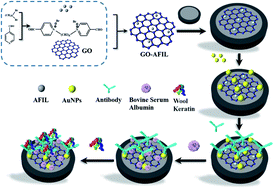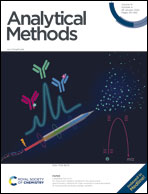Ultrasensitive dual enhanced electrochemical immunosensor to detect ancient wool relics†
Abstract
The identification of ancient wool is of great significance in archaeology; however, conventional methods are unwieldy or even ineffective when testing contaminated or severely degraded ancient samples. Therefore, it is highly desirable to develop an ultrasensitive detection method for ancient wool. In this study, an ultrasensitive electrochemical immunosensor is proposed and developed to detect ancient wool, where graphene oxide (GO), aldehyde-functionalized ionic liquid (AFIL) composites and gold nanoparticles (AuNPs) are synthesized as efficient signal amplifiers. With their large surface area and excellent electron transfer efficiency, the combination of GO-AFIL and AuNPs endows the immunosensor with excellent electrochemical properties. The fabricated immunosensor measures over a wide linear range of 0.01–100 ng mL−1 with a low detection limit of 0.9 ± 0.2 pg mL−1. Moreover, the immunosensor demonstrates excellent performance for detecting ancient wool. The identification of wool fabrics unearthed from Xinjiang, Tibet and Kazakhstan supports the historicity of prosperous sheepherding and wool trade in Central Asia during the Bronze Age.



 Please wait while we load your content...
Please wait while we load your content...